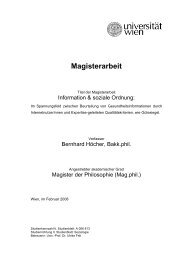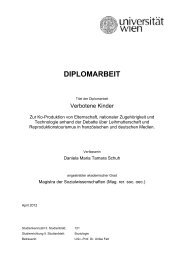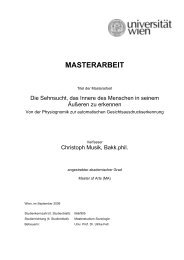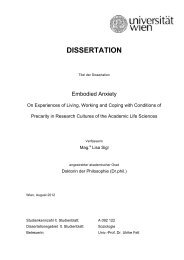MASTERARBEIT - Institut für Wissenschaftsforschung - Universität ...
MASTERARBEIT - Institut für Wissenschaftsforschung - Universität ...
MASTERARBEIT - Institut für Wissenschaftsforschung - Universität ...
You also want an ePaper? Increase the reach of your titles
YUMPU automatically turns print PDFs into web optimized ePapers that Google loves.
4.1 sts-approaches and conceptions to be used 29<br />
thinking.« [2, 281] Technological determinism argues for technologies<br />
to have essential features and qualities. These qualities, according to<br />
technological determinism, decide upon their success and the impact<br />
they have on social structure. As they are inherent in the artifact,<br />
their impact and thus also their development is forseeable and walks<br />
down a prescribed path. My approach, however, does not follow this<br />
perception but of course assumes the technological and the social coevolve<br />
and form each other. As Sismondo [45, 101] puts it: »To accept<br />
that technologies do not have essences is to pull the rug out from<br />
under technological determinism.«<br />
Further core conceptions of SCOT are the terms stabilization and closure.<br />
Those refer to the interaction/negotiation of meaning. According<br />
to SCOT, the interactions between relevant social groups lead to a<br />
»emergence of consensus and stabilization« [40, 424]. Thereby, they<br />
refer to the development on one predominant and shared perception<br />
of a technology. Usually, SCOT says, »one artifact, that is, one meaning<br />
as attributed by one social group - becoming dominant across<br />
all relevant social groups.« [2, 271] Once this stabilization progresses,<br />
the discourse about the technology will eventually experience closure<br />
through consensus. Then finally there is one meaning of a technology<br />
that is widely shared. This does, however, not mean that only one perception<br />
exists. Rather, it means one perception is predominant and<br />
commonly agreed upon. Individuals or groups may still disagree.<br />
Yet this consensus does not necessarily mean anything has actually<br />
happened.<br />
»Closure in technology involves the stabilization of an<br />
artefact and the ’disappearance’ of problems. To close a<br />
technological ’controversy’ the problems need not to be<br />
solved in the common sense of that word. The key point<br />
is whether the relevant social groups see the problem as<br />
being solved. In technology, advertising can play an important<br />
role in shaping the meaning which a social groups<br />
gives to an artefact.« [40, 427]<br />
How closure is achieved differs: problems can ’disappear’ through<br />
technological progress, they can be ’solved’ by changing surrounding<br />
conditions or they can, as one might see later in this piece, find closure<br />
through a redefinition of what the actual problem was and what<br />
it was that one was disagreeing about.<br />
The summary given of count Zeppelin‘s endeavor to create rigid<br />
airships gives a very nice example of such struggles and unforeseen<br />
difficulties. Again and again, Zeppelin interacted with relevant social<br />
groups, in his case (at least early on) mostly the Prussian military<br />
administration, about the interpretation of his technology – in<br />
that case mainly about whether the technology was seen as having<br />
enough potential to be worth fundingits further development. As has<br />
been shown, Zeppelin also looked for support by various groups and







